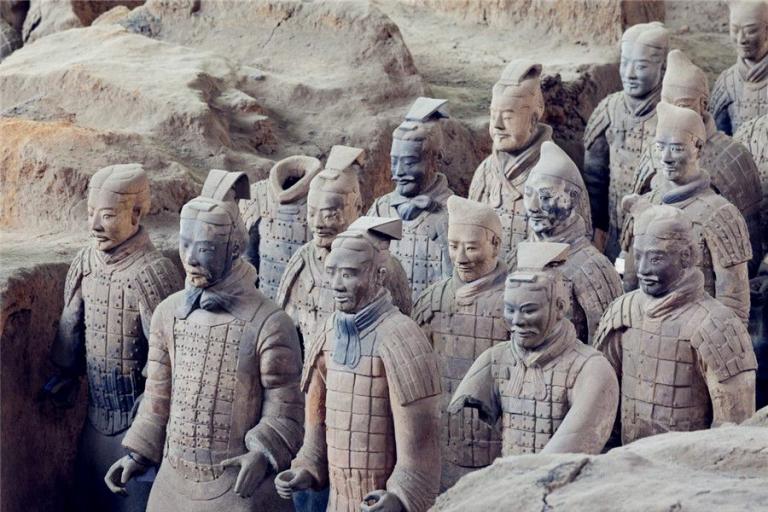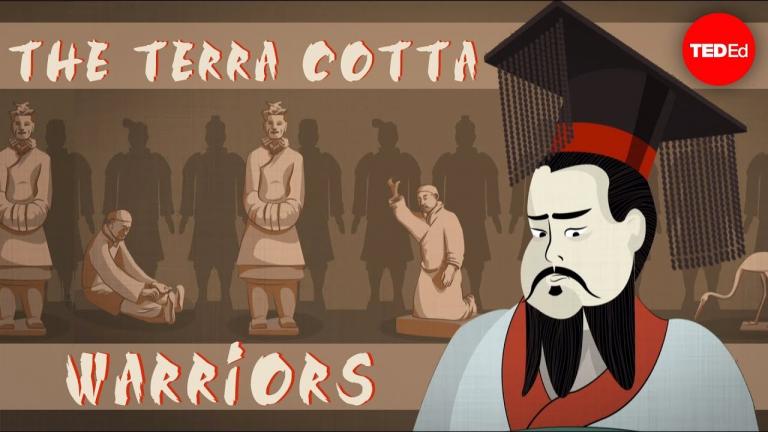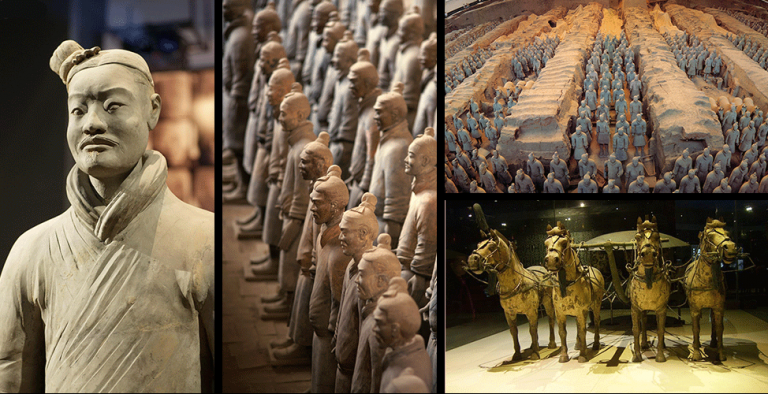Underground Mirade Terra cotta Army of Qinshihuang
5 min readAfter the unification of China, Qinshihuang (first emperor of the Qin Dynasty)gathered all resources of the nation to build his mausoleum. The terra-cottawarriors and horses, with their exquisite workmanship and consummate artisticexpression, not only demonstrate the unparalleled craftsmanship of the mighty empire, but are considered as the supreme masterpiece of ancient Chinese pottery figurine making as wel1.
Located at the foot of Mount Li, Shaanxi province, the Terra-cotta Army manifests the infinite ambitions of China’s first emperor through its mass scope, majestic force and lifelike appearances. It reached the peak of an cient Chinese pottery figurines in terms of both technique and artistry, and the massive underground army brings unprecedented sensation to people. Thus the Terra-cotta Army is praised as the eighth miracle in the world.

The Terra-cotta army, like other funerary objects in the Qin and Han dynasties, was also the result of the concept “Treat the dead as if they were still alive”. But what made it unique was that it was created by the joint efforts of the whole country. Qinshihuang, desperately in pursuit of longevity for all his life, was passionately preparing for his death while he was still waging wars to unite the coun try. He started the construction of his mausoleum soon after his enthronement, and finally it took 37 years and 700,000 workers to finish the gigantic undergroundempire, using the most advanced technology and all resources the country was able to afford.A great many historic documents have depicted this marvelous world underground, not without exaggeration. Sima Qian, in his famous work recorded that the mausoleumwas dug through to the underground spring, while the base was reinforced by copper on which the emperor’s coffin was placed. The tomb chamber was stuffed with all kinds of rare treasures, protected by settings such as crossbows and sharp swords. Then the tomb chamber was filled with mercury symbolizing rivers and lakes while luminous pearls were inlaid on the ceiling implying the hosts of heaven. Inside the coffin chamber, fish oil lamps were lit which would never extinguish. Now the mausoleum is still intact, so we can only imagine its extravagances. Nonetheless, the partially exposed burial pits of the terra-cottaarmy have already given us a great shock, and the gigantic underground troop is flaunting the glory and dream of Qinshihuang.
Different frompottery servants found in tombs of ordinary nobles and easygoing figurines of storytellers, these lifelike and orderly disposed Terra-cotta soldiers and horses, constituted a mighty force of an empire. The pits of terra-cotta army are located one kilometre away from the eastern wall of Qinshihuang’s mausoleum, and were accidentally discovered in 1970s by a local farmer. Four pits have been discovered so far, all eastward arranged, with over 8,000 terra-cotta warriors and horses,100 chariots and tens of thousands of bronze weapons-constituting an enormous underground army.

The disposal of the terra-cotta army imitates real formation. For instance, in the No 1 pit which is the largest, the troop is composed of vanguards in transverse lines, main force in 38 columns, and orderly arrayed columns at the two wings and back of the troop to defend side attacks. It clearly demonstrates the strong military force and rigorous disposal of the Qin army. In the No 2 pit northeast to the No 1 pit, the troop is arranged in the form of a try-square, and is even more spectacular than that of No 1 pit, as it consists of chariots and various arms of services. Such lifelike compositions provide us with abundant information on research of ancient arms of services, battle formations and structure of chariots.
Most of the figurines placed in the No 3 pit to northwest of No 1 pit have no heads, but according to the overall arrangement, it is likely to be the headquarters of the troop. The No 4 pit located between pits No 2 and No 3, was deserted before its completion. The three finished pits play different roles to safeguard the tomb owne from disturbance. Their discovery provided significant materials for the study of military affairs of the Qin empire.
Besides massive formations, artisans also made each single Terra-cotta figurine lifelike. They are not only of life-sizes, but are delicately portrayed in terms of expressions and gestures as well. Chariots are drawn by four horses and are grouped with infantrymen, all ready to set off.A1l the soldier figurines are strapping, with individual height between 175-180 centimetres. They are wrapped in armors or battle robes and holding spears or other weapons in their hands, with their belts tied up, hair bound and a pair of boots with square opening and uniform head on their feet.
Through elaborate portrait of artisans, each figurine boasts a vivid life with rich expressions and gestures, such as the tense soldiers ready for fight, and the contemplating generals. In June 2009, archaeologists conducted the third excavation on No 1 pit and found officer figurines for the first time. This is a precious material for studying the military ranking system of the Qin dynasty.
The production of battle robes and armors on warriors was more painstaking.
Today, we can only see the original colour of terra-cotta on figurines, but actuall they had been painted with real colours of battle robes, which unfortunately flaked off as time went by. The manufacture of chariots and horses was also realistic, as measuring proves that the size of carriage, wheel’s diameter and crossbar all perfectly match figures of real chariots of the time, while pottery horses are all1.5 meters high and 2 meters long, appearing vigorous and robust. The assemblage ofthese life-size chariots, horses and war riors vividly reproduces the glory of the Qin army.
Besides heartfelt compliments, experts are also heavily puzzled by the identity of creators of these masterpieces, as well as the craftsmanship they had applied to produce these intricate figurines. After repairing and documenting thousands ofthem, now we have made some primary progress in understanding the characters of these figurines. The clay applied was not highly fire-resistant, which may have been obtained locally. The figurines are hollow inside; most of them are first molded, then carved on details such as face before firing. Sometimes paste technique would also be occasionally applied to add extremely tiny elements such as beard and ornaments on armors.

Finally a synthetical purple pigment was painted onto figurines after firing.
Besides, some characters such as “Jianggong”,”Xianyang Wu”were found on the figurines both in seal script and official script, which some scholars suggest might be the names of terra-cotta makers. Due to lack of sufficient information, our current knowledge on the firing technique of Qin terra-cotta warriors and horses is still very limited. However, we are certain that the craftsmanship of pottery making in the Qin dynasty must have been very high to make such large and durable Terra-cotta figurines.








